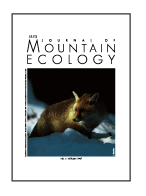|
INSECTIVORA,
CHIROPTERA, LAGOMORPHA, RODENTIA AND CARNIVORAOF THE GRAN PARADISO
NATIONAL PARK CHECKLIST AND PRELIMINARY ECOLOGICAL CHARACTERIZATION.
E. Patriarca & P.
Debernardi
Abstract - Between 1992
and 1996 a survey was carried out in the Gran Paradiso National Park
(Western Italian Alps) in order to draw up a species list and collect
ecological information on the different taxa of the orders of
Insectivora, Chiroptera, Lagomorpha, Rodentia and Carnivora, excluding
marmot and fox. Data were obtained from different sources, among which:
sighting, trapping, inspection of discarded bottles, pellet analysis
and visit to potential bat roost sites. With the exception of data from
pellets, records are reported with regard to seven habitat types: human
settlements, deciduous woods, mixed woods, coniferous woods, ecotones
(stream edges and grassland close to woods), green alder shrubwoods and
alpine open habitats far from woodland. At a more detailed level the
composition of communities of woodland Insectivores and Rodents is
described. In deciduous forests the most frequently trapped taxa were
Clethrionomys glareolus, Apodemus sp. and Sorex araneus; in coniferous
woods the dominant species were Clethrionomys glareolus and Eliomys
quercinus.
|


